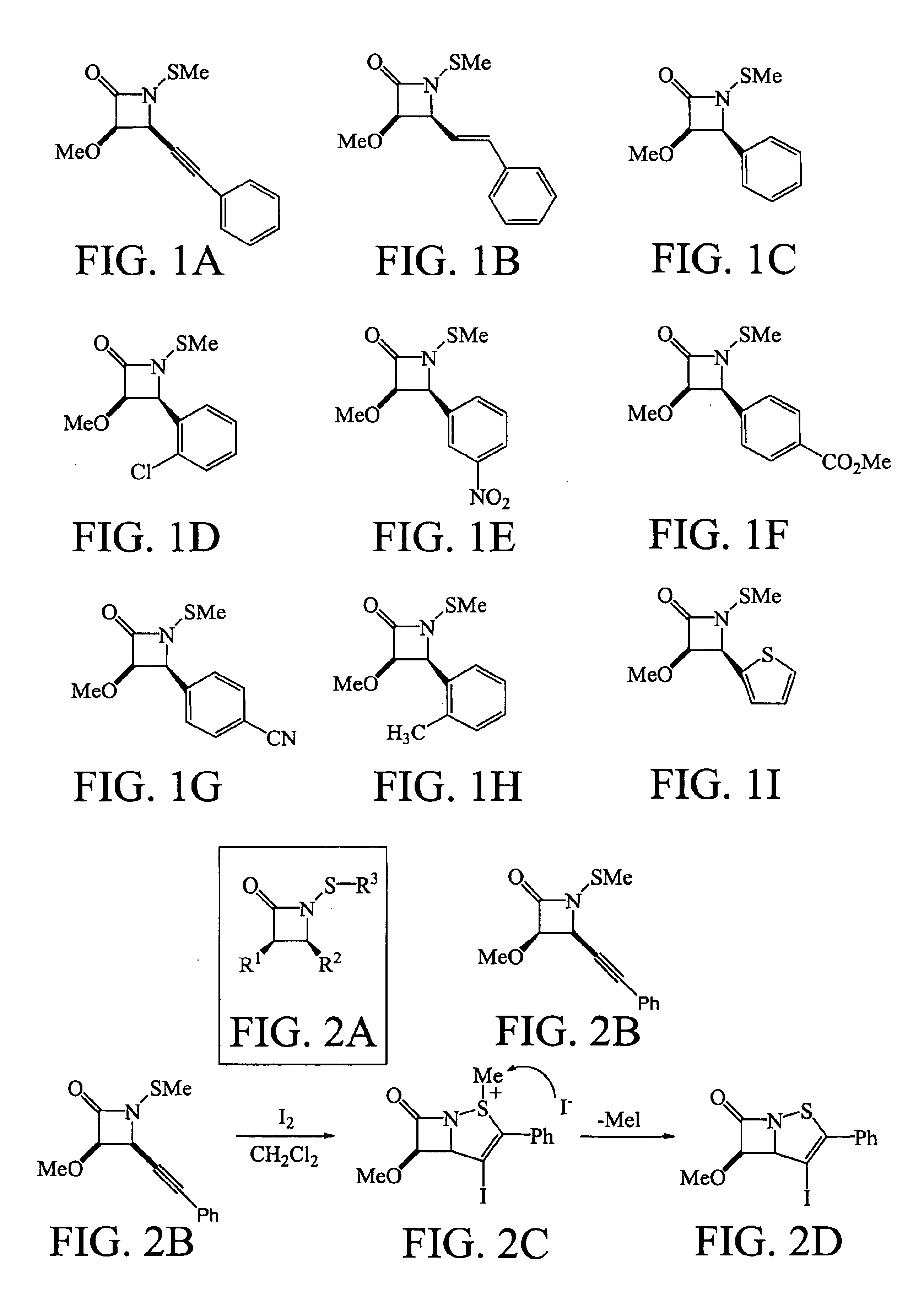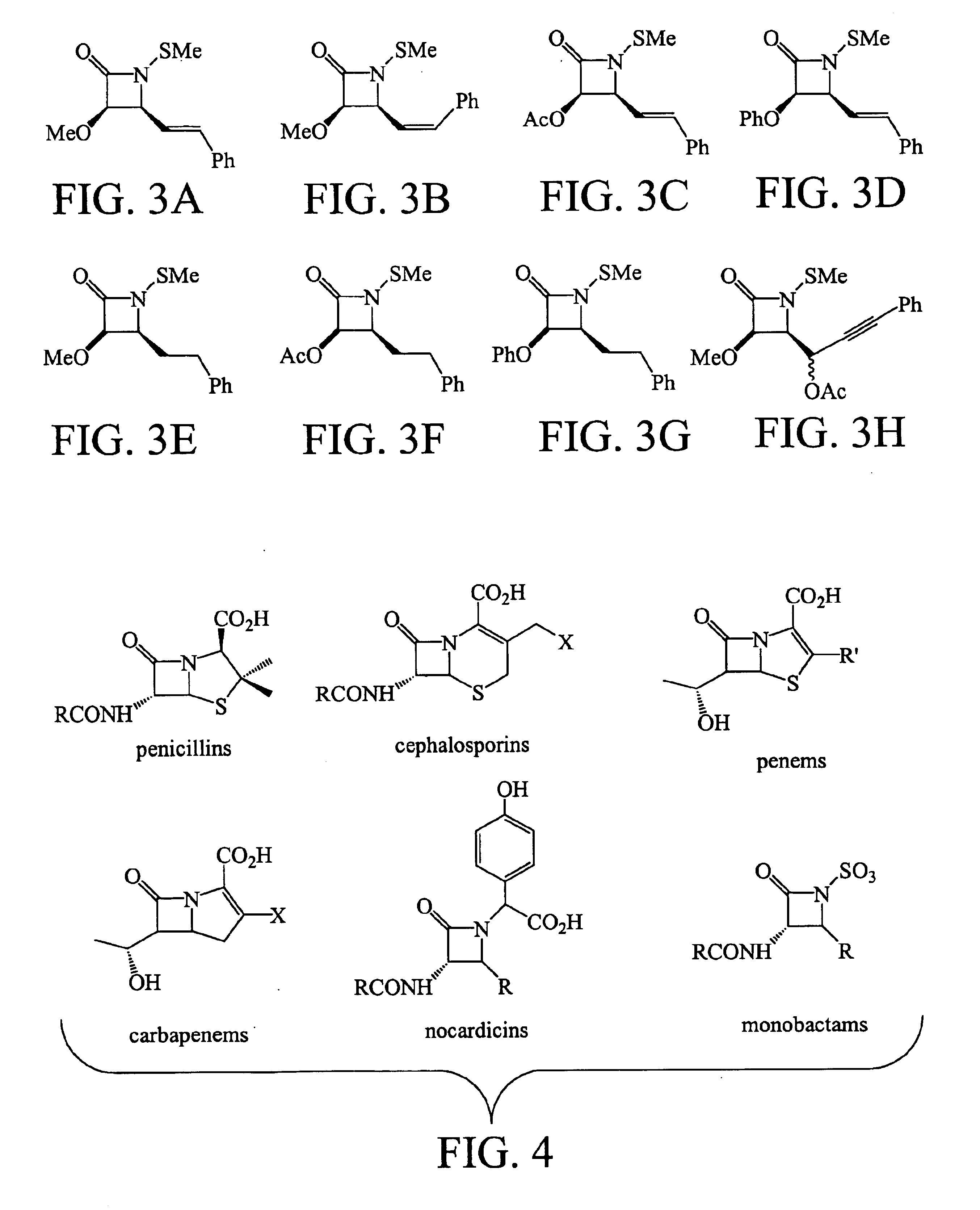N-thiolated beta-lactams: novel antibacterial agents for methicillin-resistant Staphylococcus aureus
a technology of methicillin-resistant staphylococcus and beta-lactams, which is applied in the direction of antibacterial agents, drug compositions, biocides, etc., can solve the problems of further chemical fragmentation that is deleterious to the enzyme, slowing down the introduction of new antibiotics, and alarming increase in bacterial resistance to existing agents
- Summary
- Abstract
- Description
- Claims
- Application Information
AI Technical Summary
Benefits of technology
Problems solved by technology
Method used
Image
Examples
example 1
[0069]In this study, a selection of N-methylthio-substituted β-lactams are examined for antimicrobial activity by the Kirby-Bauer disk diffusion method on agar plates. A variety of common Gram-positive and Gram-negative bacteria are tested, including clinical isolates of methicillin-resistant Staphylococcus aureus (MRSA). See FIGS. 1A-1I.
[0070]Compound susceptibility measurements are obtained from agar disk diffusion experiments using 6-mm air-dried disks impregnated with 20 μg of the test compound. The values correspond to the average diameters in mm (triplicate experiments) for the zone of growth inhibition observed after 24 h. Staphylococcus aureus (ATCC 25923) and β-lactamase-producing strains of methicillin-resistant Staphylococcus aureus (labeled as MRSA USF652-659) are obtained from Lakeland Regional Medical Center, Lakeland, Fla. Staphylococcus epidermidis, Staphylococcus simulans, Staphylococcus simulans, and Microcossus luteus are clinical isolates from University of South...
example 2
Probing the Effect of Unsaturation in the C4 Side Chain of N-Thiolated β-Lactam Antibacterials
[0080]This example is directed to the effect of unsaturation in the C-4 side chain on antibacterial activity of lactams set forth in FIGS. 2A-2D. The recent discovery of a novel family of antibacterial agents comprised of structure 1 below,
has shown for the first time that a β-lactam molecule need not possess ionic or acidic ring residues to have antimicrobial activity (Turos, E. et al. Tetrahedron, 2000, 56:5571). This is demonstrated most convincingly with the N-methylthio lactam of structure 2, whose antimicrobial activity appears to be enhanced against β-lactamase producing strains of methicillin-resistant Staphylococcus aureus (MRSA) over other common microorganisms. The structure and antimicrobial effects of this highly lipophilic compound are completely different to those of all other β-lactam antibiotics, which carry ionic or acidic functionality close to the lactam carbonyl in ord...
example 3
N-Thiolated β-Lactams: Structurally and Mechanistically Novel Antibacterial Agents for MRSA
[0087]Early profiling of N-Thiolated β-lactams 1
has revealed highly unusual structure-activity trends and a mode of action that is different to that of any current β-lactam antibiotic. Unlike penicillin and other traditional β-lactam drugs these compounds do not block bacterial cell growth by inhibiting cell wall cross-linking or penicillin binding proteins. Not to be limited by theory, experiments indicate that the lactams affect early developmental events within the cytoplasm of the cell. FIG. 4 illustrates common β-Lactam Antibiotics.
[0088]SAR studies were initiated by preparing analogues differing in the three ring substituents R1, R2, and R3. These N-thiolated β-lactam antibacterials were prepared in a single step from N-protio lactams. Synthesis of N-Thiolated β-Lactams is illustrated in FIG. 5. Most N—H lactam variants are prepared in two steps: (1) Staudinger coupling of an acid chlori...
PUM
| Property | Measurement | Unit |
|---|---|---|
| weight | aaaaa | aaaaa |
| bacterial resistance | aaaaa | aaaaa |
| antimicrobial drug resistance | aaaaa | aaaaa |
Abstract
Description
Claims
Application Information
 Login to View More
Login to View More - R&D
- Intellectual Property
- Life Sciences
- Materials
- Tech Scout
- Unparalleled Data Quality
- Higher Quality Content
- 60% Fewer Hallucinations
Browse by: Latest US Patents, China's latest patents, Technical Efficacy Thesaurus, Application Domain, Technology Topic, Popular Technical Reports.
© 2025 PatSnap. All rights reserved.Legal|Privacy policy|Modern Slavery Act Transparency Statement|Sitemap|About US| Contact US: help@patsnap.com



